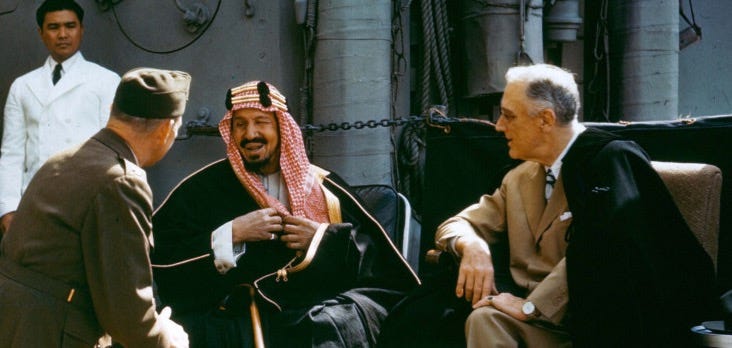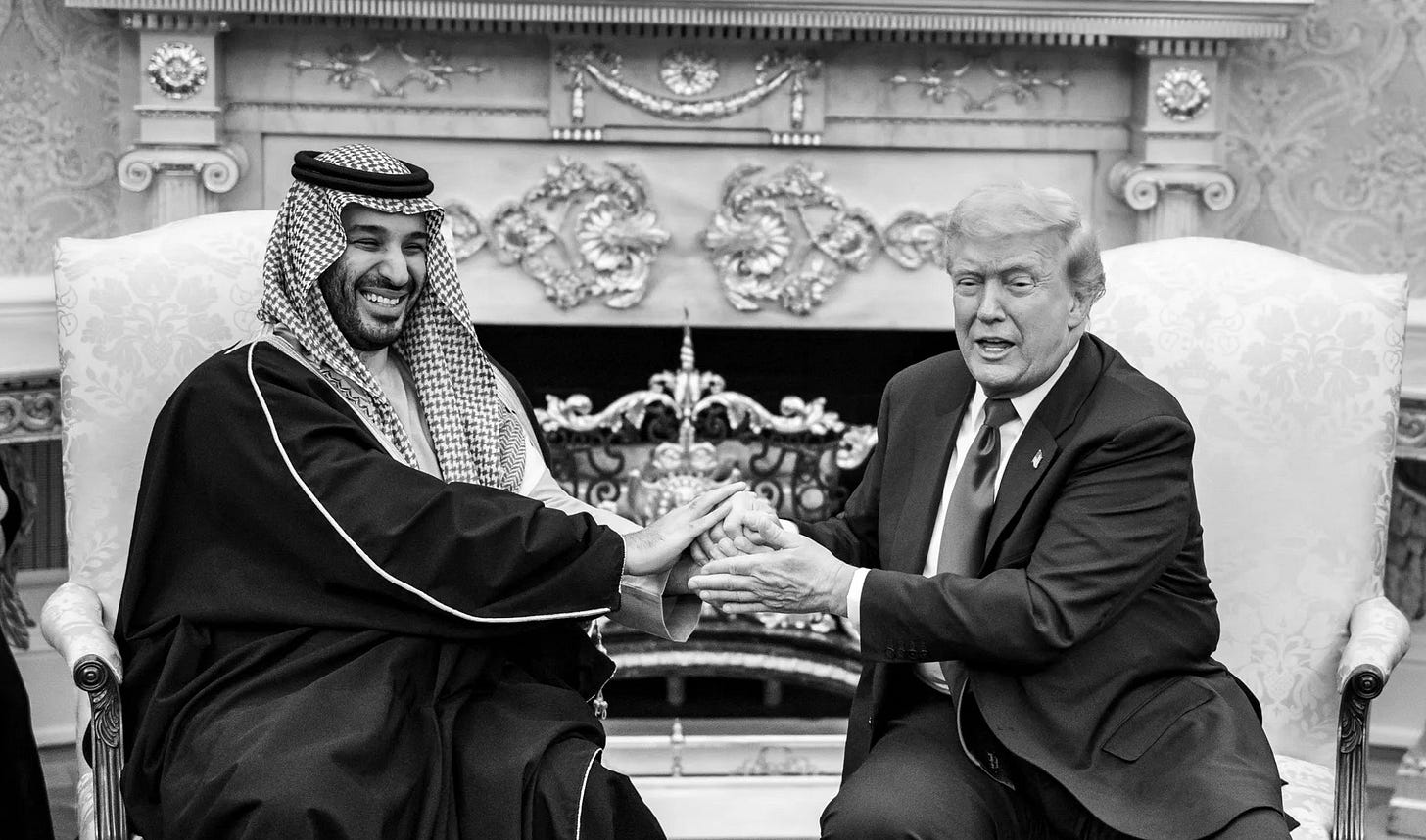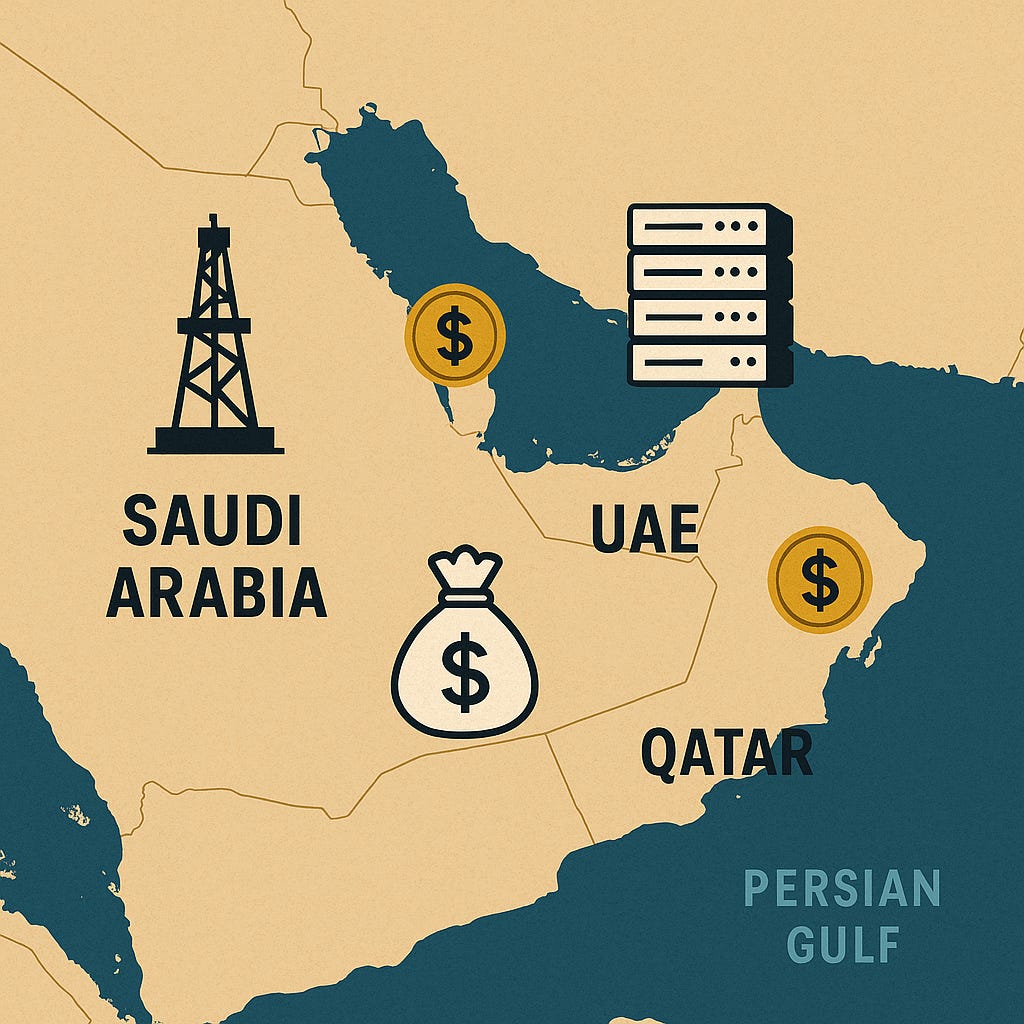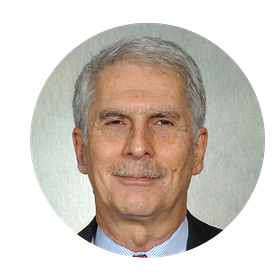A New Generation of Power
AI and the Future of the Middle East
Editor’s Note: This analysis by economist Karim Pakravan builds on our recent econVue panel on critical resources and the emerging AI–energy nexus. The full replay will be available tomorrow on econVue. Subscribe to be notified as soon as it’s available.
At a historic meeting on February 14, 1945, FDR and King Abdul-Aziz of Saudi Arabia sealed the bargain that would dominate oil markets and U.S. Middle East policy for the next 80 years: secure supplies of Saudi oil to the United States in exchange for American protection against global and regional adversaries.
Today, that framework is undergoing a profound shift. The Arab petro-powers of the Persian Gulf—Saudi Arabia, the UAE, and Qatar—are moving beyond the traditional energy-for-security compact with the West toward a more transactional, diversified, and strategically balanced posture. They are leveraging their oil and gas wealth, financial heft, and geographic position to reimagine their role in global supply chains.
King Abdul-Aziz Al Saud, the founder of modern Saudi Arabia, was the great-grandfather of Crown Prince Mohammed bin Salman (MBS). The 1945 meeting marked the beginning of the U.S.–Saudi strategic partnership, and today, four generations later, MBS is reshaping that partnership in an era defined not by oil, but by data, energy systems, and artificial intelligence.

Why the Persian Gulf Matters in a Fragmenting World
As geopolitical blocs harden and economic fragmentation accelerates, three factors are becoming decisive:
Energy
Minerals
Capital
The Persian Gulf sits at the intersection of all three. Its role is shifting from being a reliable supplier of hydrocarbons to becoming a more active player in resource networks, shaping flows of energy, metals, investment, and industrial capacity in a world of mounting great-power tension.
💬 As blocs harden, control over energy, minerals, and capital becomes destiny — and the Gulf sits at the intersection of all three.
AI’s New Geography
AI is transforming the global energy landscape. It requires:
Cheap, abundant electricity
Industrial-scale cooling
Enormous capital investment
Vast land for hyperscale data centers
The Gulf states offer:
The lowest-cost electricity in the G20
Expanding renewable output
State-backed financing
A central location between East and West
Moreover, the three petrostates operate under very different economic and demographic conditions. Saudi Arabia is the largest in terms of landmass and has a large indigenous population, while the UAE and Qatar function as small but wealthy city-states, each with massive resource bases relative to their populations. All three depend heavily on imported labor at every skill level. This combination is turning the Persian Gulf into an unlikely AI hub—a development unimaginable a decade ago.
AI has also altered the region’s strategic calculus. In Saudi Arabia, Crown Prince Mohammed bin Salman recently announced major deals between the PIF-backed HUMAN AI and leading U.S. firms—Luma AI, Elon Musk’s xAI, and a joint venture with AMD and Cisco—for the construction of large AI infrastructure in the Kingdom. The UAE has pursued a similar trajectory, striking agreements that will reshape its technological capabilities.
However, the Gulf’s entry into the AI race has not been without geopolitical friction. The UAE’s earlier alignment with China-linked firms, particularly through G42, highlighted the risks of dual-use technologies and foreign entanglement, prompting a strategic cleanup and a visible realignment toward U.S.-based partners.
Across the region, massive expansions of electricity capacity—especially natural-gas-powered—are underway to meet AI’s demands. Saudi Arabia alone plans to increase its generation capacity from roughly 83 GW in 2023 to more than 110 GW by 2028, according to the U.S. International Trade Administration — growth driven in part by the Kingdom’s data-center ambitions.
As officials frequently note, the aim is to export data, not oil. While the Gulf will continue to rely on imported expertise, and is unlikely to become an AI superpower, it will maintain a meaningful and enduring presence in the global ecosystem.
💬 The Gulf is becoming an unlikely AI hub — powered by cheap energy, sovereign capital, and an ambition to export data, not oil.”
The US–Saudi Memorandum of Understanding (MoU) on AI
A major accelerator came during Crown Prince Mohammed bin Salman’s recent visit to Washington. The White House announced a Memorandum of Understanding on Artificial Intelligence, establishing the first formal U.S.–Saudi framework for cooperation on advanced AI systems, cloud architecture, semiconductor supply, cybersecurity, and talent pipelines.
The MoU also signals a strategic shift: MBS is consciously anchoring Saudi Arabia’s technological future with a U.S. AI ecosystem, rather than a China-based one. This realignment grants Saudi Arabia regulated access to next-generation U.S. AI hardware and deeper collaboration on data-center development and training pipelines. In effect, the agreement de-risks Saudi Arabia’s entry into the global AI supply chain and elevates the Kingdom as a central partner in the emerging computational economy.
Official document:
https://www.whitehouse.gov/fact-sheets/2025/11/fact-sheet-president-donald-j-trump-solidifies-economic-and-defense-partnership-with-the-kingdom-of-saudi-arabia/

In the wake of this MoU, several industry assessments suggest that Saudi Arabia and the UAE together could support 8–12% of global AI compute capacity by the early 2030s—a mid-sized but globally significant share, enabled by low-cost energy, sovereign wealth financing, and new U.S. technology access.
While personal familiarity between MBS and President Trump helped build political momentum for the MoU, the agreement itself is institutional, and continues to draw scrutiny from parts of the Washington policy establishment.
Sovereign Wealth Funds: Power Brokers of the Gulf
The Gulf’s sovereign wealth funds (SWFs) are among the most influential global investors:
Abu Dhabi Investment Authority (ADIA) — ~$850B
Qatar Investment Authority (QIA) — ~$450B
Saudi Public Investment Fund (PIF) — ~$925B,
The UAE and Qatar continue to enjoy large surpluses and invest broadly. Saudi Arabia, however, faces growing fiscal pressure. Much of PIF’s balance sheet supports Vision 2030 megaprojects, and the Kingdom is running widening deficits. As a result, Saudi Arabia is transitioning from a capital exporter to a capital importer, a reversal of decades of financial behavior.
Mining: The Next Frontier
Critical minerals are becoming as strategic as oil once was. The Gulf states, particularly Saudi Arabia and the UAE, are positioning themselves as future hubs for mineral processing and global supply-chain integration.
Maaden, Saudi Arabia’s mining giant, is expanding across Africa and Asia, and recently announced an MoU with U.S. rare earth mining company MP Materials in May.
Joint ventures are providing access to Pakistan, Central Asia, Africa, and eventually Afghanistan.
This diversification complements the region’s move into advanced technologies by addressing the upstream constraints of the global energy transition.
Iran: The Missing Giant
Iran remains absent from this sweeping regional transformation. With more than 90 million people, a significant pool of educated and skilled labor, vast hydrocarbon reserves, enormous mineral wealth, and a key geostrategic position, it should be a major player. But decades of sanctions, internal upheaval, and economic mismanagement have isolated the country. As long as the current regime persists, this potential will remain unrealized.
Peak Oil…Delayed Again
The International Energy Agency now says global oil demand could peak not around 2030, as once thought, but sometime between 2040 and 2050. AI’s exploding electricity requirements have extended the lifespan of hydrocarbons—especially natural gas, which is emerging as the long-term winner.
Conclusion: A More Integrated Gulf Power
As global fragmentation deepens and geopolitical competition intensifies, the Gulf states are evolving from suppliers of hydrocarbons into major participants in developing the global energy, minerals, capital, and computational infrastructure. Their influence will extend far beyond oil markets. Furthermore, these states occupy a unique position at the intersection of the Global North and Global South: closely aligned with the United States and Europe, but part of the BRICS, and increasingly central to the constellation of “middle powers”. At the same time, they face a steep learning curve that will require a high degree of policy flexibility.
The Persian Gulf’s strategic value now lies not only in the hydrocarbons of the past, but in the resource networks and capital flows that will define the geopolitical economy of the 21st century.
Karim Pakravan
Karim Pakravan is an academic, global finance specialist, and consultant in the fields of emerging markets, international finance, monetary policy, and banking regulation.
📍Chicago
Also follow Karim on Substack: https://substack.com/@raeconomics
Coming tomorrow on econVue
Our full recap of last week’s panel on AI, energy, and critical resources — including the edited video replay, speaker highlights, and key takeaways.





